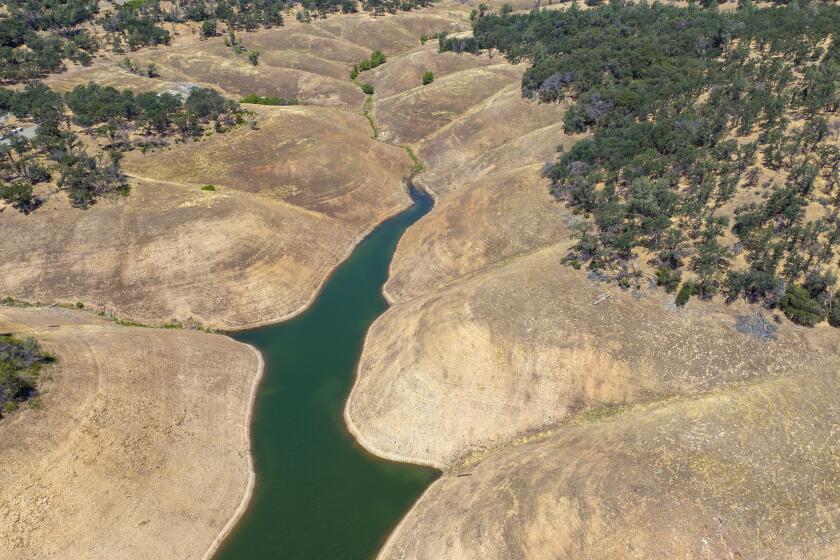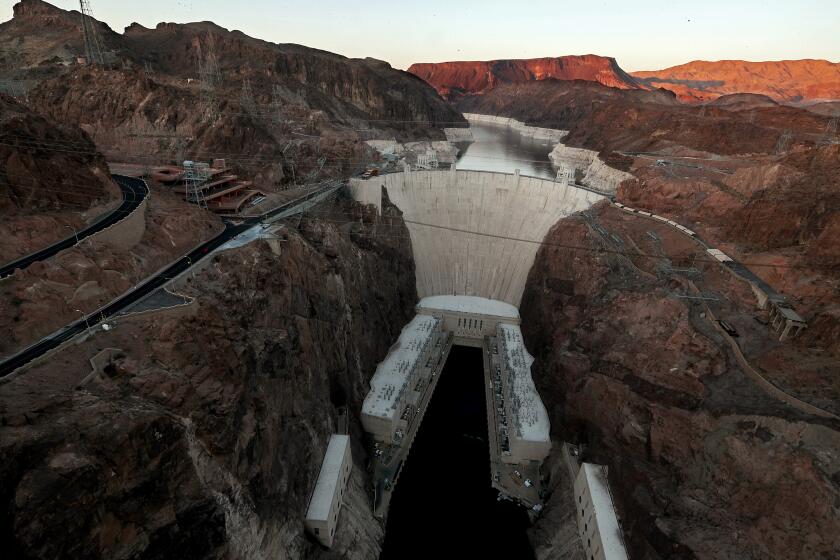
In a scathing review, advisors to the state Legislature have found that California’s proposed regulations for urban water conservation would be costly, overly complicated and difficult to implement.
State water regulators have been developing regulations, as required under 2018 legislation, that would call for water suppliers in cities and suburbs to meet increasingly stringent targets for reducing water use between 2025 and 2035. The proposed rules are intended to help California adapt as climate change brings more intense droughts and puts growing strain on water supplies.
But the nonpartisan Legislative Analyst’s Office said in its report that the regulations, as proposed by the State Water Resources Control Board, would create challenges for water suppliers, “in many cases without compelling justifications.”
The report says the proposed rules are “unnecessarily complex,” would bring significant costs and could disproportionately affect lower-income residents.
“Whether the benefits of the new rules ultimately will outweigh the costs is unclear,” the report says.
Aggressive and impactful reporting on climate change, the environment, health and science.
The proposed water-use efficiency regulations, dubbed “Making Conservation a California Way of Life,” require more than 400 urban water suppliers throughout the state to adopt water-use budgets and meet locally tailored conservation goals.
The conservation targets would vary widely depending on each supplier’s circumstances, including factors such as the area’s baseline water use, the local climate and whether many homes have lawns. According to the report, some suppliers would need to make minimal or no cuts in water use, while others would see reduction targets ranging from less than 10% to 30% or more.
Water suppliers in inland regions including the Central Valley and desert areas of Southern California would face some of the largest reductions. The proposed rules would allow for some flexibility, permitting cities and water agencies to apply for extra water in their budget or use an alternative approach to meet requirements under some circumstances.
Starting in 2027, the state could begin to fine water purveyors if they fail to meet their conservation targets.
Some of the proposed requirements “may be unrealistic for suppliers to achieve,” the Legislative Analyst’s Office said.
“We’re certainly not saying that water conservation is not an important goal. It’s one of the many tools in the state’s toolbox for dealing with more limited water supplies. But it also needs to be feasible,” said Sonja Petek, an analyst who led the review for the Legislative Analyst’s Office.
The report, which was released Jan. 4, recommends a list of changes in the proposed regulations, such as extending some deadlines and making the outdoor water-use standard less stringent. It says the Legislature now has an opportunity “to make some changes to simplify compliance, ease implementation burdens, and lower associated costs.”
Researchers with the Public Policy Institute of California have raised similar concerns, saying in a recent analysis that the proposed standards would be hard for suppliers to achieve, and that the regulations would be costly for many communities, hitting lower-income communities and inland areas harder.
The state water board’s officials will consider that feedback, as well as comments from water agencies and the public, as they prepare an updated draft proposal, which they plan to release in the spring, said Edward Ortiz, a spokesperson for the board.
The state water board then will consider adopting the regulations sometime in the summer.
The criticisms in the legislative report echo concerns raised by managers of water agencies, who have said the proposed rules would be complex and costly, presenting burdensome implementation challenges. They’ve also warned that the regulations, as written, would disproportionately affect low-income communities and potentially threaten water for trees that provide vital shade to city streets.
One organization that has called for major changes to the draft rules is the Assn. of California Water Agencies, which represents more than 470 public agencies that supply most of the state’s cities and farms.
“We’ve been working with the state water board to try to develop solutions to some of our concerns,” said Chelsea Haines, the association’s regulatory relations manager. She said water agencies hope to see changes that would “help reduce cost, ensure reasonableness for the lift water suppliers will face, provide time for Californians to make significant behavioral changes and changes to landscapes.”
Californians have dramatically reduced water use in cities and suburbs over the last decade. According to the state water board, per-capita urban water use decreased by more than 20% between 2013 and 2022.
During the last two droughts, state officials turned to emergency conservation measures to cut water use in cities and suburbs.
The long-term water efficiency rules, which include new standards for indoor and outdoor use, are intended to drive permanent reductions to adapt to worsening droughts with climate change — part of Gov. Gavin Newsom’s water strategy to prepare for an estimated 10% decrease in California’s water supply by 2040.
Haines said water agencies plan to continue to support measures to achieve more efficient water use.
“We think this regulation is really important,” Haines said. “And we just want to make sure that it’s developed in a manner that is cost-effective, is implementable, and does not result in unintended impacts.”
Citing global warming, California Gov. Gavin Newsom has unveiled a new water strategy to conserve, capture, recycle and desalinate supplies.
Others disagree with some of the criticisms leveled by the Legislative Analyst’s Office.
Tracy Quinn, president and chief executive of the environmental group Heal the Bay, said the state water board’s staff has been working to simplify and streamline the proposed rules, and held workgroup meetings over the last two months in which they discussed ways of addressing water suppliers’ concerns.
Quinn said she was surprised the legislative report “does not seem to acknowledge any of the progress that has been made in the last several months.” She also was disappointed that the report “seemed to select the worst-case data,” and she disagreed on various points, including the characterization that it’s unclear whether the benefits will outweigh the costs.
The report says the state water board has estimated the benefits of implementing the regulations at $16 billion through 2040, with those benefits accruing to customers as they buy less water, and to water agencies as they pump and deliver less. The state has estimated the costs of achieving the requirements at $13.5 billion. The costs would come as agencies pay for water-saving programs, see declines in revenue due to diminished water sales and then pass along much of the cost to customers through higher rates.
The report says the total water-savings achieved are “likely to be modest,” with the requirements estimated to result in a reduction of about 440,000 acre-feet per year, a 9% drop below what the state’s water use would otherwise be in 2035. For comparison, the total water use of Los Angeles is now nearly 500,000 acre-feet per year.
The report concludes that the estimated amount of water saved would “represent only a small fraction” of California’s total water use and notes that agriculture consumes about four times as much water as the state’s cities and towns.
“We therefore find it highly questionable whether these possible benefits would merit the amount of work and cost associated with implementing the requirements as they currently are proposed,” the report says. “These doubts are particularly worrisome given we find that suppliers will face notable challenges complying with these requirements.”
Quinn disagreed, saying the standards are achievable and the measures would bring substantial benefits.
“Certainly there are water suppliers that are going to have to do some work to comply with it. But there is an incredible amount of flexibility built into this framework to help to get them to where they need to be,” Quinn said.
From California to New England to Europe, many areas of the Northern Hemisphere are approaching a ‘snow-loss cliff’ due to global warming, researchers say.
Looking at the costs, she said, the significant water savings would be “a pretty good deal” when compared with other strategies, such as big-ticket infrastructure projects that also would require billions of dollars in investments.
“This is not only a cost-effective strategy for helping to ensure we have a reliable supply of water well into the future, but it’s also going to create a lot of benefits that are going to help our communities to be more climate-resilient,” Quinn said.
Among the benefits, she said, is that saving water also saves energy and incentivizes the shift from thirsty lawns to native plants that are better suited to withstand droughts.
“We’re closing the supply-demand gap and in the most cost-effective way possible,” Quinn said. “We know that there are significant improvements that can be made in the urban sector.”
She pointed out that researchers at the Pacific Institute found in a 2022 study that California could reduce urban water use by more than 30% by investing in measures to use water more efficiently.
Other environmental advocates have called for California to take additional steps to reduce agricultural water use.
Urban water conservation represents “a drop in the bucket compared to the savings that could be realized by adjusting agribusiness allocations,” said Max Gomberg, a former state water official who works as a consultant for the California Water Impact Network and other groups.
Gomberg said many Californians are doing their part to conserve, and the state should put a greater focus on agriculture in the Central Valley, where almonds, pistachios and other crops use vast quantities of water.
“The state needs a way to start setting some rules around agricultural water use that are going to be equitable and build our climate resilience,” he said.
At the same time, Gomberg said conserving water in cities and suburbs is also important, and the state’s regulations offer a workable approach.
Gomberg said he thinks the legislative report included some unfounded assumptions about the costs. He suggested the measures should be tailored so that customers who are using more water are charged more and encouraged to conserve, while those who use less don’t face such a cost burden.
“It doesn’t have to be cost-prohibitive if it’s implemented in an equitable way,” Gomberg said. “Low-income water users should be the beneficiaries of a more affordable rate structure.”
Toward a more sustainable California
Get Boiling Point, our newsletter exploring climate change, energy and the environment, and become part of the conversation — and the solution.
You may occasionally receive promotional content from the Los Angeles Times.










